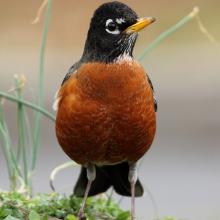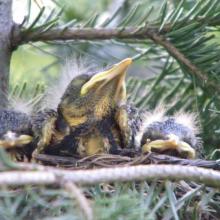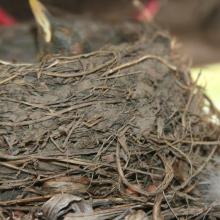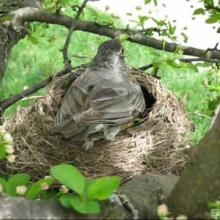

Join BirdNote tomorrow, November 30th!
Illustrator David Sibley and actor H. Jon Benjamin will face off in the bird illustration battle of the century during BirdNote's Year-end Celebration and Auction!
What was the first bird you noticed as a child? Perhaps you heard the cheery song of the American Robin coming from the top of a nearby tree. Or maybe you saw a robin running and pausing on the lawn, cocking its head before extracting a fat, juicy worm from the ground. The robin is often the first bird to wake up and start singing on a spring morning. Sign up for the BirdNote podcast! Begin here.
Support for BirdNote comes from the Cornell Lab’s Bird Academy, with online courses that share the wonder and joy of birds. More at AllAboutBirds.org.
BirdNote®
Cheery American Robin
Written by Frances Wood
This is BirdNote.
This might be the first bird you noticed as a child. [American Robin singing]
Perhaps you heard the cheery song of an American Robin coming from the top of a nearby tree. Or maybe you saw a robin running and pausing on the lawn, cocking its head before extracting a fat, juicy worm from the ground.
The male robin is often the first bird to wake up and start singing on a spring morning, sometimes well before dawn. The songster belts out his song to guard his turf from other male robins, and to advertise himself, and attract a female for the breeding season. At peak singing, the male robin might repeat his song about 2,000 times each day. [Repeat American Robin song]
For BirdNote, I’m Mary McCann.
If you ever miss a BirdNote, you can hear the latest episode. Just tell your smart speaker: "Play the podcast BirdNote." Learn more on our website, birdnote.org.
Support for BirdNote comes from the Cornell Lab’s Bird Academy, with online courses that share the wonder and joy of birds. More at All About Birds dot org.
###
Dawn song of the American Robin provided by: The Macaulay Library of Natural Sounds at the Cornell Lab of Ornithology, Ithaca, New York.
Sound recordist: W.L. Hershberger
Producer: John Kessler
Executive Producer: Chris Peterson / Dominic Black
© 2015 Tune In to Nature.org March 2018 / 2021 BirdNote Narrator: Mary McCann
ID# 031005AMROKPLU AMRO-01c









